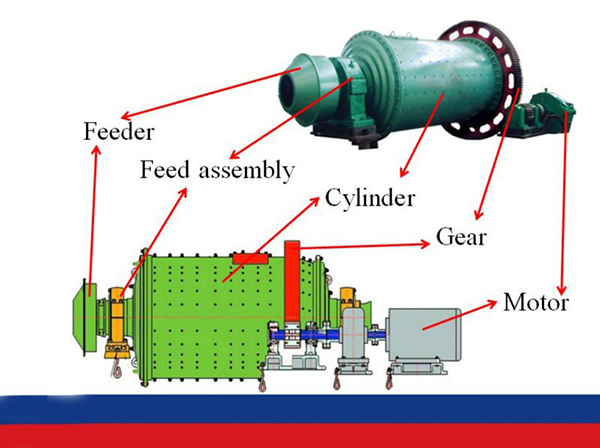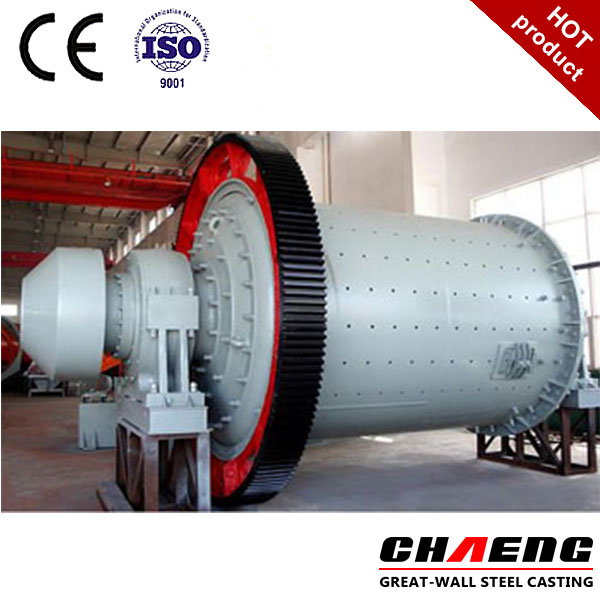Basically, a slag ball mill is a rotating cylindrical container that relies primarily on the tumbling action of chunks of ore to grind each other down to the size of coarse gravel. A supplemental grinding media (usually steel balls) assists in the process. This type of mill grinds ore that either comes directly from a mine or from a crusher. Its output is either finished size, ready for processing, or an intermediate size ready for final grinding in a secondary ball mill.
 slag ball mills can operate at a fixed speed or adjustable speed through
the use of ac synchronous motors or dc motors. They typically range up to
16,000-hp.
slag ball mills can operate at a fixed speed or adjustable speed through
the use of ac synchronous motors or dc motors. They typically range up to
16,000-hp.
In addition,or ball mill, works a lot like a slag ball mill except that it uses steel balls as the primary grinding media. It normally accepts material that passes through a 1/4-in. screen for hard ores and a 1-in. screen for soft ores, then grinds the ore to a size of 35 mesh or finer. Ballmill capacities range from 75 to 8,000 hp.
To meet the challenge of providing 18,000 hp to the mill, Allis Mineral Systems selected a ring-gear drive with two pinions. Supplying power to the pinions will be two 9,000-hp, 176.5 rpm adjustable- speed synchronous motors. With a speed-reduction ratio of 17.48:1, the drive will produce 9.35-million lbft of torque at 10.1 rpm.
A ring gear of ball mill drive offers several benefits, such as simplicity, low cost, and ease of installation. But, it requires manufacturing the largest, most powerful ring gear ever made for a grinding mill application. This task was turned over to The Falk Corp., Milwaukee, which also manufactured the two mating pinions.
Making the new gear was particularly challenging — a 43-ft ring gear had never been made due to a 40-ft limitation in gear tooth cutting machines. So Falk modified a Maag shaper cutter machine, extending its capacity to handle up to 46-ft.
 Too large to manufacture in one piece, the gear was cast in four
circular-arc segments, and their flanges were machined to ensure an accurate
match with each other. Workers then bolted the segments together and installed
the 190,000-lb assembled gear in a tooth-cutting machine called a “slasher.”
This machine makes rough cuts at high speed to approximate the final tooth
shape, thereby reducing total cutting time for the ring-gear teeth by about 40%.
Then the gear moved to the Maag shaper cutter, which generated the 71/2-deg
angle helical teeth, Figure 2, to their proper involute shape, moving at a
slower rate to obtain a smooth finish of about 80 min. and an accuracy of GW
Quality 10. Pinion tooth surfaces were machined to a 32 min. finish, and
accuracy of GW Quality 12, which reduces friction and dynamic losses.
Too large to manufacture in one piece, the gear was cast in four
circular-arc segments, and their flanges were machined to ensure an accurate
match with each other. Workers then bolted the segments together and installed
the 190,000-lb assembled gear in a tooth-cutting machine called a “slasher.”
This machine makes rough cuts at high speed to approximate the final tooth
shape, thereby reducing total cutting time for the ring-gear teeth by about 40%.
Then the gear moved to the Maag shaper cutter, which generated the 71/2-deg
angle helical teeth, Figure 2, to their proper involute shape, moving at a
slower rate to obtain a smooth finish of about 80 min. and an accuracy of GW
Quality 10. Pinion tooth surfaces were machined to a 32 min. finish, and
accuracy of GW Quality 12, which reduces friction and dynamic losses.
After inspection, workers disassembled the gear into its four segments and shipped them, along with the two mating pinions to Chile in December 1994. The gears are scheduled to be installed on the slag mill at the mine in June 1995. They will be driven through clutches by two 9,000-hp, 176.5 rpm adjustable-speed synchronous motors made by Great Wall.
Prev:How to safely transport slag ladle
Next:slag vertical roller mill lead the development of slag processing industry
- Tel: +8619838076183
- Whatsapp: +8619838076183
- E-mail: casting@chaeng.co
- Skype : GreatWall1958


